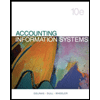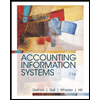
Narrative 1: Good Buy, Inc (good-buy.com)
Good Buy, Inc. (a fictitious company) sells a variety of consumer pro-ducts through its Web site, good-buy.com. Good Buy's IT infrastructure consists of a front-end Web server that interacts with customers and a back-end ERP system that manages the inventory and performs other typical ERP functions. The sales order process begins when a customer logs an to the good-buy.00m Web site. The customer requests the company catalog and the Web server obtains the current Good Buy online catalog fmm the ERP system, which sends the catalog to the Web server, and the server displays it to the customer. The customer selects the items and quantities that he or the wants to purchase; the Web server edits the customer input for accuracy (e.g, ensures that all required fields have been selected or frilled in) and sends this list on to the ERP system, where the requested quantities of inventory are allocated for the sale. The ERP sends back to the Web server the quantities that have been allocated, and the Web serverdisplays this information on the customer's semen. The customer verifies that the order is correct and completes the sale by entering his or her shipping and credit card information. The Web server edits this data for accuracy (e.g, enmra that all required fields have been selected or filled in and that the length of the entered credit card number is correct) and sends the credit card information and amount of the sale on to the credit card company. The credit card company sends back a verification number, and the Web server notifies the customer that the sale has been completed by displaying a confirmation number on the customer's screen. The Web server also notifies the ERP system that the sale has been completed, and the ERP system changes the status of the inventory from allocated to sold, prints a pick-ing ticket or packing slip in the warehouse, and records (on the enterprise database) a sale and an account receivable from the credit card company.
Use the narrative(s) as selected by your instructor, to prepare a table of entities and activities.
Want to see the full answer?
Check out a sample textbook solution
Chapter 4 Solutions
ACCT INFO SYSTEMS (ACCESS CODE)
- No AI Which of the following is NOT a characteristic of common stock? A) Voting rights B) Dividends C) Guaranteed return on investment D) Ownership in the companyarrow_forwardWhich of the following would be considered an example of an operating activity in a cash flow statement? A) Issuance of common stock B) Borrowing from a bank C) Payment for goods sold D) Purchase of equipmentarrow_forwardNo chatgpt!! What does the Price-to-Earnings (P/E) ratio measure? A) Profit margin B) Dividend yield C) Market valuation relative to earnings D) Return on equityarrow_forward
- I need help in this question!! What does the Price-to-Earnings (P/E) ratio measure? A) Profit margin B) Dividend yield C) Market valuation relative to earnings D) Return on equityarrow_forwardWhat does the Price-to-Earnings (P/E) ratio measure? A) Profit margin B) Dividend yield C) Market valuation relative to earnings D) Return on equityarrow_forwardWhat is the risk-free rate typically associated with? A) Corporate bonds B) Government securities C) Real estate investments D) Equitiesarrow_forward
- No chatgpt! Which of the following financial instruments is used to hedge against interest rate risk? A) Futures contracts B) Treasury bills C) Interest rate swaps D) Corporate bondsarrow_forwardWhich of the following financial instruments is used to hedge against interest rate risk? A) Futures contracts B) Treasury bills C) Interest rate swaps D) Corporate bondsarrow_forwardNeed assistance! Which of the following is the best description of a dividend? A) The amount a company spends on research and development B) A payment made to shareholders from company profits C) The price of a company’s stock D) The cost of producing goods for salearrow_forward
- I need help in this question! Which of the following is the best description of a dividend? A) The amount a company spends on research and development B) A payment made to shareholders from company profits C) The price of a company’s stock D) The cost of producing goods for salearrow_forwardNo AI Which of the following is the best description of a dividend? A) The amount a company spends on research and development B) A payment made to shareholders from company profits C) The price of a company’s stock D) The cost of producing goods for saleNeed help!arrow_forwardDo not use ChatGPT! Which of the following is the best description of a dividend? A) The amount a company spends on research and development B) A payment made to shareholders from company profits C) The price of a company’s stock D) The cost of producing goods for salearrow_forward
 Pkg Acc Infor Systems MS VISIO CDFinanceISBN:9781133935940Author:Ulric J. GelinasPublisher:CENGAGE L
Pkg Acc Infor Systems MS VISIO CDFinanceISBN:9781133935940Author:Ulric J. GelinasPublisher:CENGAGE L Accounting Information SystemsFinanceISBN:9781337552127Author:Ulric J. Gelinas, Richard B. Dull, Patrick Wheeler, Mary Callahan HillPublisher:Cengage Learning
Accounting Information SystemsFinanceISBN:9781337552127Author:Ulric J. Gelinas, Richard B. Dull, Patrick Wheeler, Mary Callahan HillPublisher:Cengage Learning Accounting Information SystemsAccountingISBN:9781337619202Author:Hall, James A.Publisher:Cengage Learning,
Accounting Information SystemsAccountingISBN:9781337619202Author:Hall, James A.Publisher:Cengage Learning, Auditing: A Risk Based-Approach to Conducting a Q...AccountingISBN:9781305080577Author:Karla M Johnstone, Audrey A. Gramling, Larry E. RittenbergPublisher:South-Western College Pub
Auditing: A Risk Based-Approach to Conducting a Q...AccountingISBN:9781305080577Author:Karla M Johnstone, Audrey A. Gramling, Larry E. RittenbergPublisher:South-Western College Pub College Accounting, Chapters 1-27AccountingISBN:9781337794756Author:HEINTZ, James A.Publisher:Cengage Learning,Principles of Accounting Volume 1AccountingISBN:9781947172685Author:OpenStaxPublisher:OpenStax College
College Accounting, Chapters 1-27AccountingISBN:9781337794756Author:HEINTZ, James A.Publisher:Cengage Learning,Principles of Accounting Volume 1AccountingISBN:9781947172685Author:OpenStaxPublisher:OpenStax College





